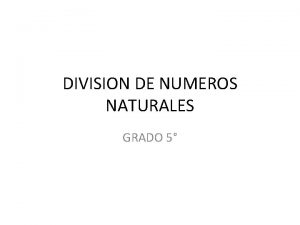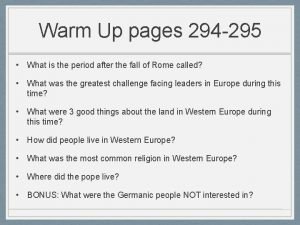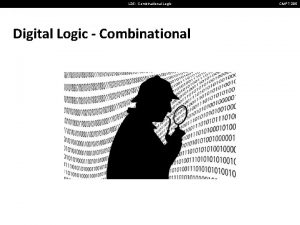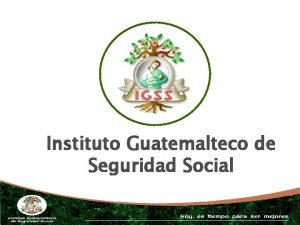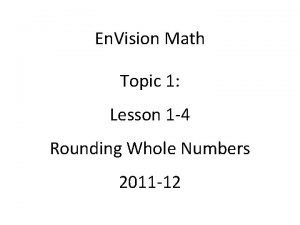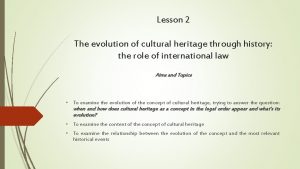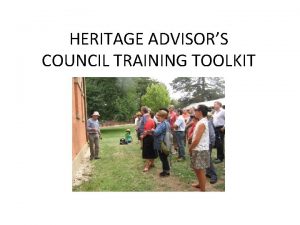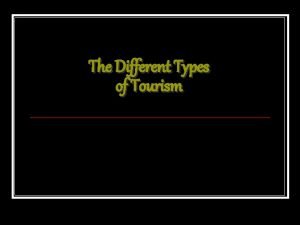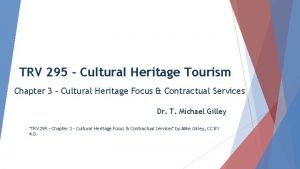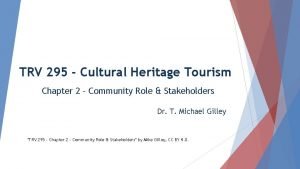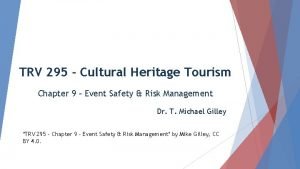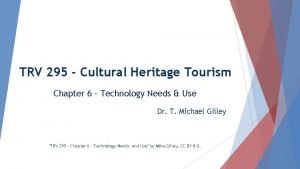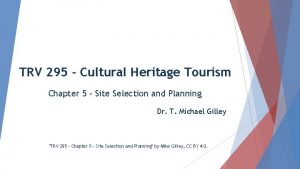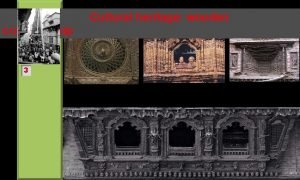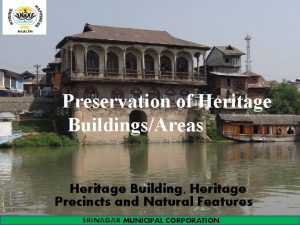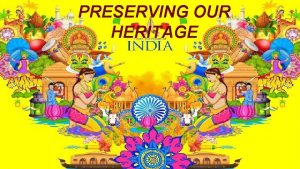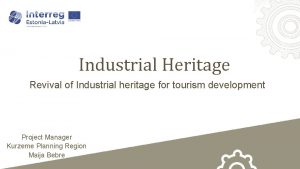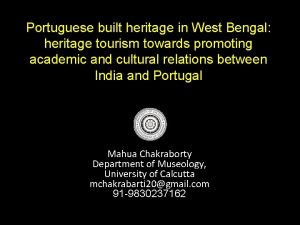TRV 295 Cultural Heritage Tourism Chapter 1 Introduction

















- Slides: 17

TRV 295 - Cultural Heritage Tourism Chapter 1 – Introduction to Cultural Heritage Tourism Dr. T. Michael Gilley "TRV 295 - Chapter 1 - Introduction to Cultural Heritage Tourism Event Planning and Management" by Mike Gilley, CC BY 4. 0.

Learning objectives of this course ▶ Identify and examine the elements of cultural heritage tourism events: ▶ Roles of the community and stakeholders; ▶ Event focus and contractual services; ▶ Event vision, mission, and strategic planning; ▶ Event site planning and selection; ▶ Event technology needs and uses; ▶ Event concessions; ▶ Event staff and volunteers; ▶ Event safety and risk management; ▶ Event marketing and promotion; ▶ Event customer satisfaction;

▶ ▶ Event evaluation; and ▶ Event budgeting and sponsorship. Identify different practices of these elements by examining three similar cultural heritage tourism events from case studies: ▶ Blue Ridge Folklife Festival, Ferrum College; ▶ Home Craft Days, Mountain Empire Community College; and ▶ Merle Fest, Wilkes Community College. ▶ For your research project for the class, identify and adopt a cultural heritage tourism event, interview coordinators of the event, and identify the best practices for each element of your chosen event – develop a case study. ▶ On the mid-term and final exam, identify terms and concepts of cultural heritage tourism event planning and management.

What is cultural heritage tourism? ▶ Cultural heritage tourism is the visiting and observing or participating in living cultures or cultures handed down or built from the past (Gilley, 2016; Mc. Kercher & du. Cros, 2002; Richards, 2007; Smith, 2009; Timothy, 2001). ▶ Cultural heritage includes “material objects such as buildings, rural landscapes and villages, cities, art collections, artifacts in museums, historic gardens, handicrafts, and antiques as well as non-material elements of culture including music, dance, beliefs, social mores, ceremonies, rituals, and folklore” (Gilley, 2016; Timothy, 2001). ▶ Sustainable tourism is “tourism that takes full account of its current and future economic, social, and environmental impacts, addressing the needs of visitors, the industry, the environment and host communities” (Gilley, 2016; United Nations, 2011).

What is the dichotomy in cultural heritage tourism? The dichotomy of cultural heritage tourism exists between the reality of the cultural heritage and the economic needs of tourism as a for-profit business. Cultural heritage tourism not only exists to present the cultural heritage of a particular community, but also to preserve the cultural heritage and to draw visitors to the community to support the economic development of that community. The tourist who does not share the cultural heritage of that community may have different expectations of the cultural heritage event or destination. If the event cannot draw and satisfy the tourists, it will fail in its economic efforts. If the coordinators of the event change the depiction of the event to satisfy the tourist’s expectations, then they do not preserve the heritage, but change the true dimension of the cultural heritage, perhaps losing community support. There needs to be a balance to preserve the cultural heritage while building economic development.

How do we balance the cultural heritage and the tourism in cultural heritage tourism? ▶ ▶ The National Trust for Historic Preservation (2012) lists five principles for developing a successful cultural heritage tourism program: ▶ Collaboration among community organizations, ▶ Coordinated match for community and tourism, ▶ Interactive sites and programs, ▶ Quality and authenticity, and ▶ Conservation and preservation of resources. Involve many stakeholders from the local community holder of the cultural heritage on the Board or Planning / Oversite Committee as well as ones from local tourism / economic development authorities.

Cultural Heritage Tourism Case Study 1: Blue Ridge Folklife Festival ▶ The first Blue Ridge Folklife Festival took place in 1973 on the campus of Ferrum College class to showcase the local folklife through the traditional farming and household processes as well as the decorative/functional crafts and performing arts for leisure. This festival continues to showcase the local crafts and music as well as storytelling, dance, and folkways (Gilley, 2016). ▶ The mission statements of Ferrum College mention community development, service, and support. The leaders of this college also envision roles with cultural heritage tourism for rural community and economic development and cultural heritage preservation (Gilley, 2016). ▶ Ferrum College established the Blue Ridge Institute and Farm Museum in the early 1970 s for the preservation of the folk heritage of the Blue Ridge area. Although the Blue Ridge Institute, Museum, and Festival were not envisioned to support local economic development, an economic impact study coordinated with Virginia Tech shows this festival contributes to the economic development of the local community and region with an impact of approximately one million dollars (Gilley, 2016).

Cultural Heritage Tourism Case Study 2: Home Craft Days ▶ The first Home Craft Days Festival took place in the fall of 1972 on the campus of Mountain Empire Community College as a student project with Roddy Moore’s folklore class to showcase the local crafts and music. This festival continues to showcase the local crafts and music as well as storytelling and dance (Gilley, 2016). ▶ The mission statements of Mountain Empire Community College mention community development, service, and support as well as cultural activities, development, enrichment, opportunities, and renewal. The leaders of this college also envision roles with cultural heritage tourism for rural community and economic development and cultural heritage preservation (Gilley, 2016). ▶ Although Home Craft Days was not envisioned to support local economic development, antidotal evidence suggests that the festival contributes to the economic development of the local community and region. An economic impact study has not been conducted for Home Craft Days (Gilley, 2016).

Cultural Heritage Tourism Case Study 3: Merle Fest ▶ Merle Fest started in 1988 as a one time fundraising concert to establish a garden for the blind to memorialize Eddy Merle Watson, the son of the late Doc Watson. The fund raiser was so successful that the college decided to continue it. It has grown from a one-day, one-stage festival to a four-day, thirteen-stage festival. (Gilley, 2016). ▶ The mission statements of Wilkes Community College mention community development, service, and support as well as cultural activities, development, enrichment, opportunities, and renewal. The leaders of this college also envision roles with cultural heritage tourism for rural community and economic development (Gilley, 2016). ▶ The leaders of Wilkes Community College saw the economic development potential of Merle Fest after the first festival. It is the largest fundraiser in western North Carolina, raising over fifteen million in the early 2000. (Gilley, 2016).

Three Case Studies: The Similarities and Differences ▶ Blue Ridge Folklife Festival, Home Craft Days, and Merle Fest are similar in that they are long standing cultural heritage tourism events focusing on the traditional Appalachian culture. All three festivals were started by and at higher educational institutions. They differ in the degree to which the festivals focus on Appalachian heritage culture, the ways they present the culture, the identified economic development, the preservation of the culture, and the purpose for starting and continuing the festivals. ▶ Blue Ridge Folklife Festival, the second oldest of the three festivals is held at and sponsored by the Blue Ridge Institute and Museum at Ferrum College. It is called a folklife festival focusing on the folk ways of life in the Appalachian region. It was started and supervised over the years by a professional trained folklorist. The festival documents and showcases the local people, their processes and use of certain tools to create shelter, clothing, food, and entertainment for daily living during a particular time period of that region.

Supported by a museum and archives which aims to document and preserve the Appalachian culture of a specific region and time period, the festival focuses on illustrating this culture as authentically as possible. All aspects of the culture and community life from buildings; work processes; tools and materials used; items produced; clothing worn; animals for work, materials, and food; vegetation; foodways; children’s games; storytelling; music; and dance. It has stayed true to its mission to accurately represent and preserve the heritage culture. As it grew in attendance, it also grew it its ability to have an increasing impact on the local and regional economy, particularly non -profit endeavors as reported in 2015. The economic impact on the local and regional areas was reported as several million. Any funds made from the festival go to continuing the festival and supporting the Blue Ridge Institute and Museum (Gilley, 2016).

➢ Home Craft Days Festival, the oldest of the three festivals is held at and sponsored by Mountain Empire Community College. It is called a craft festival focusing on the folk craft production in the Appalachian region. It was started as a student project in a folklore class under the supervision of the same professional trained folklorist, who started the Blue Ridge Folklife Festival a year later. This folklorist was hired by the college to supervise a heritage craft production program when the college first opened in 1972 during a craft revival movement. The early festival was very similar to today’s Blue Ridge Folklife Festival in documenting and showcasing the local people, their processes and use of certain tools to create shelter, clothing, food, and entertainment for daily living for the service region of the college, far southwest Virginia. The festival did not focus on a particular time period. When the folklorist left Mountain Empire Community College to go to Ferrum College, the festival continued under the Continuing Education Division of the college, which later became the Workforce Division.

Over the years, the food served in the food court has changed from Appalachian to International, with more carnival food offerings. This festival provides more economic opportunities currently to independent food vendors whereas, it supported student and community groups as food vendors in the past. There are less demonstrators for the traditional craft production processes and more selling of hand-made crafts, not necessarily representing the Appalachian region. More emphasis is placed on music and dance with less older performers and more younger performers. The music performance has widened to include more bluegrass, blues, and Americana. The music has been digitally preserved over the years. Although craft production has been preserved through photographs, there has been very little video footage taken of the craft production processes. The musicians and craft producers have not been interviewed with an ongoing basis to document and preserve this culture.

This festival like the Blue Ridge Folklife Festival provides and economic opportunity to regional artisans and musicians. Home Craft Days has not stayed true to the mission of the early festivals to document and preserve the Appalachian culture of a specific region. The festival’s attendance has grown over the years; however, its impact on the local and regional economy is unknown. Any funds made from the festival go to continuing the festival with the greatest financial support coming from the college’s local funds budget, followed by the local governments (Gilley, 2016).

➢ Merle Fest, the youngest of the three festivals is held at and sponsored by Wiles Community College. It was started in 1988 as a one time fundraising concert to establish a garden for the blind to memorialize Eddy Merle Watson, the son of the late Doc Watson. The fund raiser was so successful that the college decided to continue it. It has grown from a one-day, one-stage festival to a four-day, thirteen-stage festival. The focus of this festival is music, as Doc Watson stated “traditional plus” music, which includes the traditional, roots-oriented music of the Appalachian region such as old-time, classic country, bluegrass, folk, gospel, and blues as well as other styles such as Americana, and classic rock. The music offerings feature in-door and outdoor performances and workshops, as well as community jams, and dances. Although Merle Fest focuses on the music, this festival also showcases local and regional arts and crafts. It is the largest fundraiser in western North Carolina, raising over fifteen million in the early 2000. Although this festival features traditional heritage music and crafts, that is not the focus of Merle Fest. The focus is economic development (Gilley, 2016; Roueche & Jones, 2005).

Assignment for Week 1 ▶ Go to the Blackboard site for this course and post a thread under the discussion board, introducing yourself and your interest in cultural heritage tourism. ▶ List the cultural heritage event that you want to research and learn more about. Please make contact with leaders who coordinate the event you will research and develop during this course and secure their assistance with your research project for this course. Email his, her, their name(s) and email address(es) to me at mgilley@mecc. edu. ▶ Then in a post, please share what you can learn from your event leaders about the event and its role in cultural heritage representation and preservation as well as local and regional economic development. Are the roles of authentic representation and preservation balanced with the role of economic development? ▶ This will be the start of developing a case study on your event. As you review your event, continue to ask this question and note if any aspect of the event needs to change for the recommended balance of the cultural heritage representation and economic development impact for sustainability.

Resources ▶ Gilley, T. M. (2016). Institutions of higher education and cultural heritage tourism: A case study of the Crooked Road, Virginia’s heritage music trail. Ann Arbor: Pro. Quest. ▶ Mc. Kercher, B. , & du Cros, H. (2002). Cultural tourism: The partnership between tourism and cultural heritage management. New York: Routledge. ▶ National Trust for Historic Preservation. (2012). Cultural heritage tourism fact sheet. Retrieved from http: //www. preservationnation. org/informationcenter/economics-of-revitialzation/heritage-tourism/Resources/2011 -CHTFact-Sheet-6 -11. pdf ▶ Richards, G. (2007). Cultural tourism: Global and local perspectives. New York: Routledge. ▶ Roueche, J. E. , & Jones, B. R. (2005). The entrepreneurial community college. Washington, DC: American Association of Community Colleges. ▶ Smith, M. K. (2009). Issues in cultural tourism studies. London: Routledge. ▶ Timothy, D. J. (2011). Cultural heritage and tourism: An introduction. Bristol: Channel View Publications.
 Sapratibandha
Sapratibandha World heritage is our heritage slogan
World heritage is our heritage slogan Classification of property under hindu law
Classification of property under hindu law Divisiones para quinto grado
Divisiones para quinto grado Pages 294 and 295
Pages 294 and 295 Cmpt 295
Cmpt 295 Decreto 295
Decreto 295 Round 493 295 to the nearest ten thousand
Round 493 295 to the nearest ten thousand Round 493 295 to the nearest ten thousand
Round 493 295 to the nearest ten thousand Komax 331
Komax 331 Kj no 295
Kj no 295 Cultural heritage meaning
Cultural heritage meaning Intangible cultural heritage and sustainable development
Intangible cultural heritage and sustainable development Hudhud chants of the ifugao threats
Hudhud chants of the ifugao threats The byzantine empire preserved the cultural heritage of
The byzantine empire preserved the cultural heritage of Heritage advisors
Heritage advisors Mass tourism vs alternative tourism
Mass tourism vs alternative tourism What is interpersonal motivators in tourism
What is interpersonal motivators in tourism



